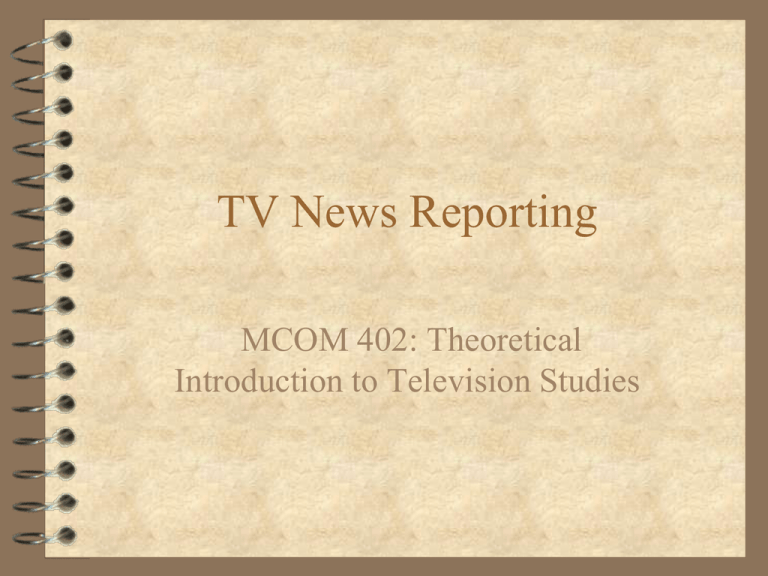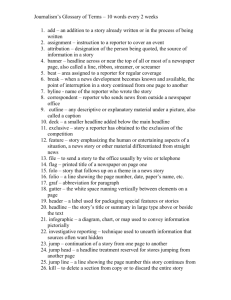TV news reporting
advertisement

TV News Reporting MCOM 402: Theoretical Introduction to Television Studies Styles of TV News Headlines, Teases Readers or links Std VO Newsroom VO package Reports or packages from the field Two ways Live shots with reporters Walk throughs Studio Chats The TV news package There are four elements to any package: – The intro/ cue read by the anchor – The pictures/footage/graphics – The links/voice over – i.e. the reporter’s words read over the pictures – The soundbites from the interviewees featured in the package The TV news package A package is a story May be pre-planned or reactive to a hard story If pre planned feature--- researched, set up, structured, shot, written, voiced, edited, broadcast The TV news package Contains GV or B roll pictures Interviews which become sound bites or SOTs A stand up or PTC A written narration or VO Effects or Graphics Common Terms Actuality –audio clip or video bit from an interview or other recording Line timing –determining length by line count Live –not prerecorded Toss –anchor lead-in to package story Standard out cue –reporter’s last few words Common terms Package – pre-recorded, self-contained story introduced by the anchor and delivered by reporter. All stories end with ### or (XXX) VO – voice over VO-SOT --voice over sound on tape Standup (on camera) reporter on camera for television news – Open, – Close, – Bridge Common terms ACK -Actuality –sound from the story itself, NAT for natural sound or WILD for wild sound, or RAW for raw sound. Voicer –same as Reader- In radio or television this story has no actualities. A story read aloud by the newscaster. Does not contain ACK. Wraparound –reporter’s voice wrapped around an actuality TV News Writing Tips Keep it simple Keep it conversational Use present tense making the story immediate. Use Declarative, short sentences Try something besides the who, what, when, where, why and how in your lead. Use a sentence for each idea. You should be able to read each sentence aloud in just one breath. TV News Writing Tips Time limitations Boil down your story to the most essential elements. Broadcast news is constrained by time. The simplest stories tend to run in just 30 seconds. Speed at which newscasters read –about 140-180 words per minute Audiences just cannot absorb as much information listening to a broadcast story as they could reading a story of similar length. TV News Writing Tips Use Round Numbers Shorten long titles Names and initials: Omit middle names and initials unless a person is well known by his middle name or initials. Do not use the courtesy titles or ‘Mr’ ‘Ms’ ‘Mrs’. Don’t use unfamiliar names in leads. Instead characterize the person by what has made him newsworthy. TV News Writing Tips Attribution: Attribution is the most basic tool of journalism. You want your audience to know it, that’s why the attribution comes at the beginning of the sentence so there will be no mistaking who said what. Avoid direct quotes: The listener cannot see the quotation marks in a copy. If you feel you must use a direct quote, alert your listener that it’s coming. For example: Wrong: ‘I am not a crook’ the President said. Right: The President said, in his words, ‘I am not a crook’ LEADS FOR BROADCAST STORIES LEADS FOR STORIES Lead is the most important part in a news story because it sets the tone for all that follows. Grab or hook the audience’s attention. Can be exciting, dramatic, clever, intriguing or provocative. Unless it is a feature, the lead must have an element of news and must answer the 5 W’s and H. There are a number of leads and a variety of ways to lead a story. The decision of which lead to use depends on a number of factors, the most important being the nature of the story. LEADS FOR STORIES The Hard Lead: It tells the vital details of the story immediately. Usually used for breaking news. For example: Atleast 30 people were injured in the collapse of a building. More than 20 dozen people were arrested in the drug bust. The Soft Lead: Alerts the audience to the news that is to follow. Sometimes called ‘warming up’ the audience. For example: A building collapses in Lahore. Atleast 30 people have been injured. A major drug bust in Karachi. More than a dozen people are under arrest LEADS FOR STORIES Throwaway Lead: Similar to newspaper headline. Summarizes information that will follow later in the story Umbrella lead: Often called shotgun lead, summary lead, comprehensive lead and round-up lead, ties together related stories. Most frequently used with national and international news. Provides smooth transition from one story to another. For example: Stories on the energy issue can be related…gas rationing ;;to.. cutbacks in crude oil sales by oil-producing countries.











